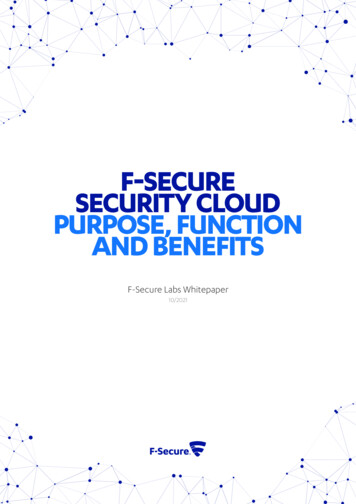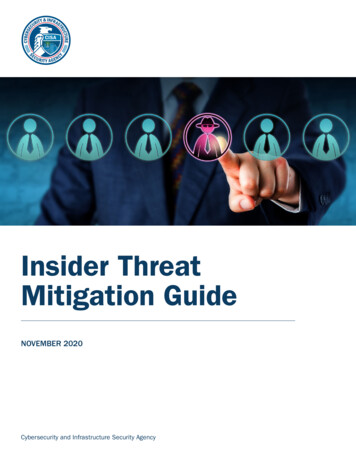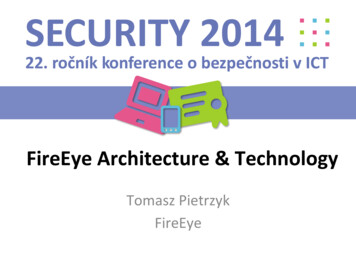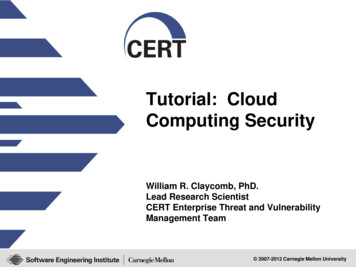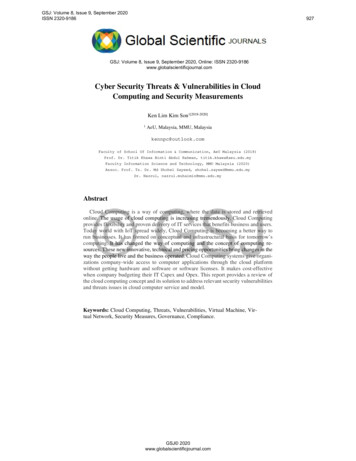
Transcription
GSJ: Volume 8, Issue 9, September 2020ISSN 2320-9186927GSJ: Volume 8, Issue 9, September 2020, Online: ISSN 2320-9186www.globalscientificjournal.comCyber Security Threats & Vulnerabilities in CloudComputing and Security MeasurementsKen Lim Kim Son1[2018-2020]1AeU, Malaysia, MMU, Malaysiakennpc@outlook.comFaculty of School Of Information & Communication, AeU Malaysia (2018)Prof. Dr. Titik Khawa Binti Abdul Rahman, titik.khawa@aeu.edu.myFaculty Information Science and Technology, MMU Malaysia (2020)Assoc. Prof. Ts. Dr. Md Shohel Sayeed, shohel.sayeed@mmu.edu.myDr. Nazrul, nazrul.muhaimin@mmu.edu.myAbstractCloud Computing is a way of computing, where the data is stored and retrievedonline. The usage of cloud computing is increasing tremendously. Cloud Computingprovides flexibility and proven delivery of IT services that benefits business and users.Today world with IoT spread widely, Cloud Computing is becoming a better way torun businesses. It has formed on conceptual and infrastructural basis for tomorrow’scomputing. It has changed the way of computing and the concept of computing resources. These new innovative, technical and pricing opportunities bring changes in theway the people live and the business operated. Cloud Computing systems give organizations company-wide access to computer applications through the cloud platformwithout getting hardware and software or software licenses. It makes cost-effectivewhen company budgeting their IT Capex and Opex. This report provides a review ofthe cloud computing concept and its solution to address relevant security vulnerabilitiesand threats issues in cloud computer service and model.Keywords: Cloud Computing, Threats, Vulnerabilities, Virtual Machine, Virtual Network, Security Measures, Governance, Compliance.GSJ 2020www.globalscientificjournal.com
GSJ: Volume 8, Issue 9, September 2020ISSN 2320-918692821IntroductionCloud computing has been defined as a technology model for enabling convenient,on-demand network access to a shared pool of configurable computing resources including servers, applications, network, storages and other computing services that canbe rapidly provisioned and released with minimal management. The cloud computingis also a latest technology trend of information technology with computing services thatprovided to computers and other devices on-demand. According to a Gartner report(2011), cloud computing is the first top 10 technologies and trends that will be strategicfor most organizations. The objective of cloud computing is to offer faster, flexibilityin data storage, and network services with computing resources visualized as servicesand delivered over the Internet (Zhao G, et al., 2009, p.347-358). As per figure 1,thecloud is a distributed architecture with a centralized server and network resources offerspotential of data management, ubiquitous access, self-service provisioning and virtualization. It aims for cost reduction, optimization, flexibility, acceleration of work development, agility, scalability, availability and ability to adapt to change and other computing service as per demand. To give a more efficient computing service to the people.According to a Gartner report (2011), cloud computing is the first top 10 technologiesand trends that will be strategic for most organizations.Figure 1: The discipline of cloud computing’s elements. (Source: Jose Moura & DavidHutchison, 2016)Cloud computing are formed by leveraging many technologies including Web 2.0Service, Service Oriented Architecture, virtualization to optimize the resources utilization and other technologies that provide a common platform for user’s computingneeds. The hardware systems and software systems and applications delivered as services over the Internet are formed up as a cloud computing. Cloud computing servicesare distributed from data canters sited all over the world and makes possible for its usersto use the virtual resources via internet as per requirement.GSJ 2020www.globalscientificjournal.com
GSJ: Volume 8, Issue 9, September 2020ISSN 2320-91869293Adopting cloud computing comes with benefits and barriers to adoption. The most significant barriers are security, privacy, legal and compliance issues. These barriers aredue to the uncertainties on the security on cloud computing services including networkon the cloud, infrastructure on the cloud, application on the cloud, data and informationin the cloud, etc. Such uncertainty becomes a main concern of the information executives and companies that planning to embark to cloud platforms. The information executives and companies concerned about how to smoothly move their infrastructure,applications and data including sensitive data to the cloud. Security is their primaryconcern when transmitting data over the Internet and from the cloud systems to user’scomputers. Not only that, the security holds the data in the cloud and concerns relate torisk areas including data storage, internet that depends externals internet service providers, are the public dependency link, control access, multi-tenancy, security integration become a big question mark for them.The different between on-premise infrastructure and network, cloud platform has itslarge-scale resource distribution, almost a complete virtualize platform and heterogeneous in the configuration by the cloud providers. The common security measurementplace within on-premise infrastructure and network such as basic authentication, identity management and some form of authorization is no longer sufficiently or flexiblefor such security and interoperability in cloud computing platform. Hence, cloud computing is inheriting risks to organizations as compared to the existing on-premise infrastructure and network systems.The security issues of cloud computing can be categories within three service models,security issues for Platform as a Service (PaaS), Infrastructure as a Service (IaaS) andSoftware as a Service (SaaS).As far as SaaS is growing, the security for this model is a big question, e.g. if a virtualserver that hold ten virtual machines has been hacked, the all ten machines are at risk.The identity management for this model is not mature because SaaS itself from thecloud providers are usually not able to integrate the SaaS platform. Due to softwareservice sharing pool, the control level is limited (refer to figure 2) and the data secrecymay be weak too. Access from anywhere and anytime comes with risks, usually SaaSthat enables it mobility, e.g., smartphone is not equipped with security features.Figure 2: The control responsibilities for cloud provider and users in SaaS model.(Source: Jose Moura & David Hutchison, 2016)GSJ 2020www.globalscientificjournal.com
GSJ: Volume 8, Issue 9, September 2020ISSN 2320-91869304Most organizations are concerned about the security implications associated with PaaSmodel and its data privileged access, distributed architectures and data location. According to Char Sample (2018), the challenge in encrypting the data is the main obstaclefor PaaS model. Similarly, the control is limited in this cloud service especially at application and operating system layers.Figure 3: The control responsibilities for cloud provider and users in both PaaS andIaaS models. (Source: Jose Moura & David Hutchison, 2016)Similarly, IaaS model exposes security issues. The concern over the control access,permission, database access rights that applied to application layers. Requirements likeData Lost Prevention (DLP), location tags, data access rules, robust delegation of administration might not be able to enable by the IaaS model. Multi-tenants sharing thesame storage is the key concern in IaaS platform as well, the data may be commingledwith data from other tenants.Cloud computing services are categories as a public cloud and a private cloud. Cloudsolutions like Microsoft Azure is an example of public cloud, anyone can access whenservice applications and storage that are being provided over the Internet (IJER, 2014,p.221). A private cloud is usually for internal usage and manage by in-house IT teamor outsourced to a 3rd party that comprise resources sharing of computing serviceswithin organizations. A community cloud is another type of private cloud where a feworganizations have similar requirements and sharing infrastructure so to realize someof the benefits of cloud computing.Threats and vulnerabilities are common risks that lead to a misconduct in using/managing of information and data when some vulnerable flaws are exist in the systems thatmakes attacks to be successful. The finding of vulnerabilities and threat among threecloud models is discussed in this report including what cloud service models are affected by such threats and vulnerabilities. The report will address how these threats andvulnerabilities can be exploited to perform attacks, the relationship between threats andvulnerabilities and relevant countermeasures to address these issues within the cloudcomputing platforms.GSJ 2020www.globalscientificjournal.com
GSJ: Volume 8, Issue 9, September 2020ISSN 2320-918693152Security Problems in Cloud ComputingCloud computing is the provision of dynamically scalable and often virtualized resources as a service over the internet. Users need not have knowledge of, expertise in,or control over the technology infrastructure in the "cloud" that supports them. Cloudcomputing represents a major change in how we store information and run applications.Instead of hosting apps and data on an individual desktop computer, everything ishosted in the "cloud"—an assemblage of computers and servers accessed via the Internet. Cloud computing services often provide common business application online thatare accessed from a web browser, while the software and data are stored on the serversover the Internet. In such services, the standardization work in the cloud computing hasits interoperability issues, more critically the security issues including both vulnerability and threat that arise in the cloud services regardless in any SPI model. The purposeof this topic as a basis of the literature review is to analyse security issues in cloudcomputing with a brief description on the identification of vulnerabilities and threats.A number of security issues have been identified which are broadly categorized according to the area of interest in this study. The general. A relevant mitigations and securitymeasurements are discussed in the report to provide homogeneity security issues thatmay lead to the attack and giving analysis of data collected from the literature reviewand security with its correctness actions that can be applied as practical actions to fixthose gaps and issues that have been identified. The nature of cloud is combined withdifferent services utilized of APIs and interfaces, model of consumption and resourceallocation with provisioning, management, self-services, orchestrations for dynamic allocation of resources based on the giving systems and application input. These leads toprobability and interoperability with limitations in regardless of any model in SPIwithin public cloud or private cloud. Both have significant results in limited control,configuration, security protections and availability variances (Jaydip Sen, 2014).Figure 4: Areas of security concerns in cloud computing. (Source: Jaydip Sen, 2014)There is substantial security attention of security vulnerabilities and threats that required security countermeasures to fix. The landscape of vulnerability and threat tosecurity in cloud computing change as organizations move to the cloud. Cloud serviceGSJ 2020www.globalscientificjournal.com
GSJ: Volume 8, Issue 9, September 2020ISSN 2320-91869326systems and applications including its data and content can be exploited and manifestin new and different ways other than through the old vectors that exist in the cloudcomputing. It is critical that to acknowledge that the cloud structure and its architecturesin the SPI model can mitigate current security vulnerabilities and threats in order tomake sure that cloud computing satisfies organizational security requirement. In thisreport, the examination is carried out for the vulnerabilities and threats against data andinformation asset residing in the different cloud service models, the security issues withthe cloud and relevant considerations of attacks and availability issues and securitycountermeasures, as well as some sample of cloud security vulnerabilities and threatsincident (Jaydip Sen, 2014, p.9).GSJ 2020www.globalscientificjournal.com
GSJ: Volume 8, Issue 9, September 2020ISSN 2320-918693373Objective of Security MeasuresThe objective is to organize an investigation in an attempt to gain solution to thesecurity issues in the cloud computing services. The key objective is also to find out theproper security measurements for cloud computing including architecture of the mostflexible and secure cloud environment. Removes many of security headaches that comewith infrastructure with relevant security measures with security solutions. Increasingsecurity posture in the cloud including visibility into usage and resources which answering and validating the hypothesis of security vulnerabilities and threats that relateto the cloud services. A conceptual framework to address the objectives as part of thedevelopment of security issues identification that results in relevant security measurements.Figure 5: a conceptual framework of independent and dependent variables of securitymeasurements for cloud computing (source: Larry Dragich, 2012).GSJ 2020www.globalscientificjournal.com
GSJ: Volume 8, Issue 9, September 2020ISSN 2320-918693484Cloud Review4.1Cloud Service ModelsThe service model is also known as SPI model – Software, Platform and infrastructuremodels provides the following servicesFigure 6: Cloud SPI models – SaaS for application layer, PaaS for platform layer andIaaS for infrastructure layer. (Source: 360logica.com, 2018)a.SaaS allows customer’s application as a service that running on a cloud infrastructure. Users can access the application over the Internet from their computers ordevices, e.g. mobile device. In most cases, no upfront cost is needed for SaaS becausethe model offered as on-demand services. The cost to host applications is rathe low,customers only need to pay, managed and maintain the hosted applications, no underlying infrastructure cost is involved in this model including cost for servers, operatingsystems, network and storages. Some SaaS example is Salesforce, Microsoft Azure,Zoho Expenses, etc.b.PaaS provides a platform for customers to build higher level service in thecloud without a local platform for servers and operating system. Customers would havethe capability to deploy applications including systems and operating system support,software applications, and development to offer as a service. Customers can control ormanage their application layers without managing the underlying cloud infrastructureincluding servers, network, storage, etc. in most cases, mixture of servers and operatingsystems are offered by PaaS providers, such as Linux server, MySQL, etc.GSJ 2020www.globalscientificjournal.com
GSJ: Volume 8, Issue 9, September 2020ISSN 2320-91869359c.IaaS offers computing services and resources over the internet. The infrastructure is hosted in the cloud offer customer creation of virtual machines, install operatingsystems, deploy databases such as SQL and provision of storage for centralize repository server, backup and its retention. IaaS allows customers to access and manage theirinfrastructure to monitor performance, troubleshoot application issue, manage serversand applications load balance, manage firewalls, manage costs and manage data protection including disaster recovery and etc. Microsoft Azure services and AmazonAWS are the providers offer IaaS services.Figure 7: Cloud computing’s architectural model. (Source: Jaydip Sen, 2014)Understand of relationship and security challenges of these three cloud service models is critical. As shown in the figure 7, IaaS is the foundation of all cloud services withPaaS building upon IaaS and SaaS is built upon PaaS. In some cases, it is trusting thatthe built are on the other way around.These three models are always relating to each other, a PaaS platform can be used todeploy IaaS and SaaS, an IaaS can be built as a PaaS and offered SaaS. Each modelhas its own inherent security flaws, when these models are dependant to each, numerousof security challenges can come simultaneously. These security issues lead to a numberof security concern, including legal and compliance, risk management, access controlfor infrastructure, applications and network layers, and cloud provider dependant risks.For example, SaaS are depending on the cloud providers with minimal controls, IaaSwith a common problem because cloud providers own the underlying infrastructure, thecustomers do not have insight/visibility of their infrastructure and they will not havetransparency of the configuration since cloud providers keeping all the details and configurations.GSJ 2020www.globalscientificjournal.com
GSJ: Volume 8, Issue 9, September 2020ISSN 2320-918693610The security result may be inconsistent for these models with a mixture of securityprotection related to the authenticity and credibility of the cloud services and cloudproviders. Hence, trust is a big issue which raises security concerns to use cloud services. (Ryan & Falvy, 2012). Confusions may be created if an attack is happening especially cloud computing service is shared amongst customers.4.2SaaS Security IssuesThe model is typically on-demand services, such as CRM and ERP applications (Ju J,et al., 2010, p.384-387), email and instant messaging, conferencing, etc. customerswould have less visibility of the security of the services which also the least controlamong the three-delivery model in the cloud. Due to less visibility and control, it exposes security risks and concerns over the adoption of SaaS applications and services.Figure 8: Business model in SaaS delivery services. (Source: Kannan Subbiah, 2012)The business model for software service includes hosting infrastructure, support multitenancy, scalability and internationalization. These services are discussed in the following sub-chapters which cover the application security, multi-tenancy, data security andaccessibility to the mentioned software services.a. Application SecurityApplications can quickly change the world, empower business and connect usersaround the globe. However, without proper security built-in during development theseapplications can be compromised by attackers to put user data at risk, cripple user trustwith the application, and result in financial losses or regulatory fines.GSJ 2020www.globalscientificjournal.com
GSJ: Volume 8, Issue 9, September 2020ISSN 2320-918693711Likewise, applications from the cloud computing services create certain vulnerabilitiesbecause these applications usually are delivered through the Internet (Ritinghouse, Jw,Ransome JF, Jensen M, et al., 2009, p.109-116). Users used it via web browsers, assuch some flaws in the web applications are expected. Web browsers are always themost favourite tool that used by attackers to initiate an attack to compromise users’computers. Attackers used the web to perform attach, such as stealing or grapping ofsensitive data (Owen D, 2010). In the past, application in the local network are noteffectively protected from attacks, but applications in the cloud computing, such asSaaS platform are required new security approaches (Subashini S, Kavitha V, 2010) toprotect it. E.g. developer assume some parts of applications can’t be seen or tamperedwith or invoked by the users, the impact led to access control failure. Access controlincluding authorized data access and access to privileged functionality.Application hosting in the cloud is permitted to access by authorized users includingHTTP and HTTP traffic to permit services. But a typical firewall does not protect anapplication, it protects traffic and access may be logged but the details of applicationand it traffics are rarely investigated because many malicious activities do not how ‘abnormal’ traffic or behaviour. Similarly, antivirus software installed on the client machine detects system level issues, not the security issues detected from the browser. Upto a certain extent, a compromise application may operate normally. There are moresecurity issues for applications, e.g. 3rd party application linked to business site. One ofthe best practices to begin the application protection is follow the identified top tensecurity threats that define in the OWASP.b. Multi-tenancyIn SaaS model, multi-tenants are sharing the same underlying infrastructure and sameresources including software services. In this case, the administration of service andsupport is also be shared. This is because of cost deduction, cost sharing and resourcesharing among tenants. Sharing of same application stack which multi-tenant’s data arestored in the same database and the database can be moved on an unencrypted networkdevice and managed by common application process (OWASP, 2018), as such, it is achallenge for logical security in the application to split one tenant’s users from others(OWASP, 2018). The sharing of underlying infrastructure and software services cometo certain security risk including shared services could become a single point of failure,change control may not be able to co-ordinated, weaker logical security control betweentenants, which malicious or ignorant tenants may decrease the security posture of othertenants. Sometimes, a single instance application or database serves multi-tenants(Chong F, et al., 2011), as such the risk of data leakage between tenants is high. Assuggested by Bezemer C-P (2010), security policies are required to make sure that different customer’s data are kept separate.If attacker or hackers can compromise the application and database, chances of gettingor stealing of data of hundreds of different customers who stored their application anddatabase in the cloud is high. Majority multi-tenant cloud computing services are created by web 2.0 which may pose in new user interfaces and lack of security features.E.g. attacker initiated an attack by using WebGoat v5.4. SQL injection attacks thatGSJ 2020www.globalscientificjournal.com
GSJ: Volume 8, Issue 9, September 2020ISSN 2320-918693812represent a serious threat to any database-driven application that shared among tenant.Such attack methods are easy to learn and successfully compromise the system. Thedamaged causes can range from considerable to complete system compromise for multiple users. Despite these risks, an incredible number of systems on the internet sharingamong users are susceptible to this form of attack.c. Data SecurityA key concern for technology is the data security. It is one of the major challenges forSaaS model which customers/users are relying on the cloud provider to have a propersecurity and security baselines when embarking to the cloud services. Data is always inplaintext format when it is stored. When data is stored in plaintext formation, hackerscan obtain access to information, collecting information about your systems, accesspersonal data for ID theft, to commit user transaction fraud more easily. Hence, it iscritical that SaaS provider to provide the security measurement for the data that is beingstored and processed in the cloud (Ju J, et al., 2010, p. 384-387). Backing up and recovering of data in the cloud expose to security challenges (Subashini S, Kavitha, 2010)when facilitate the backup for recovery in an event of disaster recovery is needed. Somecloud service providers sub-contract the data protection strategy to the 3rd party serviceproviders in order to have backup and recovery process in place to meet the audit andbusiness continuity purposes, such sub-method raise security concerns as well becausethe cloud provider may have lost visibility to the data that is being backed up by the 3rdparty service providers.The process of compliances is complex in the SaaS model, the data is stored in thecloud provider’s data centres, some cloud service providers do not envision the compliance standard with its regulations in the cloud computing (Rittinghous, JW, 2009)which led to security and privacy issues that should be enforced by the cloud provider.It is always good practice to sanitize all input data, especially data that will used in OScommand, application parameters and scripts, and database queries, as such, not onlyit is easily instigated, it is also a threat that, with a little common-sense and forethought,can easily be prevented even if the threat like SQL injection, cross-scripting attackshave been prevented in some other manner.d. Data AccessibilityCloud computing offers accessibility in convenience and makes access from anywhereand anytime from any Internet connected devices including mobile connected in thepublic WIFI hotspot and home connected computers. As such it exposes certain securityrisks and challenges. According to the Cloud Security Alliance (2012), today’s mobilecomputing and the top ten threats and vulnerabilities including insecure Wi-Fi networkespecially open hotspots, information stealing malware are found in the operating system in any IoT device, proximity-based hacking, official applications and non-securemarketplaces. A report by Media Access Australia (2014), acknowledged that cloudbased services have challenges in accessibility because both application and web services offer different cloud accessibility features, such feature is for easy to use way andsimplicity when it comes to access, hence, it exposes to weak security protection.GSJ 2020www.globalscientificjournal.com
GSJ: Volume 8, Issue 9, September 2020ISSN 2320-9186939134.3PaaS Security IssuesThis model of cloud computing offered applications over the Internet without on-premise hardware, storages and software. PaaS application security consist of security forthe platform and security of the applications that deployed on the platform. PaaS providers are responsible for securing the platform software stack. The security includesdatabases engine runs the applications. The security issues are the main roadblock fordelaying of IT modernization. Refer to figure 8d c, to the finding by Cioinsight (2018),the biggest barrier of PaaS adaption is the security issues and operational risks (43%)for PaaS platform as compared to the failure to demonstrate needed ROI (39%), lack ofbudget (49%) and inability to recognise the value of PaaS and related services (32%).Figure 9: IT modernization is delayed by security issues. (Source: Cioinsight, 2018)Cioinght, 2018. IT modernization delayed by security issues. Available atThe common PaaS security issues and challenges are described as follow:a. 3rd Party RelationshipPaaS offers 3rd party web services. The services component including mashup that mixsingle element of sources that inherits security issues such as network security, datasecurity, etc. Users on a PaaS platform are relying on security in web services, 3rd partyservices and development tools, thus users are not getting grips with 3rd party data andnetwork security underlying in the PaaS platform.b. Development Life CycleSetting up application security is a big challenge for developers in the development ofapplications. The speed at which application will change in the cloud will affect bothsecurity development in application and system development life cycle (Ritighouse,JW, 2009).GSJ 2020www.globalscientificjournal.com
GSJ: Volume 8, Issue 9, September 2020ISSN 2320-918694014Figure 10: Cloud service model’s Development Lifecycle. (Source: Cloudyinnashvile.com, 2018)The iteration has never stopped for platform development lifecycle (DLC). SuchDLC is applicable to all cloud service models. Frequently upgrade of PaaS by developers become an essential for application development processes and make it flexible tokeep up with technology changes (Ertaul L, Singhal S, 2010). Certainly, such changesincrease security issues and can compromise the security of the applications. Other thandevelopment, data stores on different location with different legal regimes can compromise its security and data privacy, moreover if the data is stored in inappropriate locations, legal issues may arise.c. Underlying Infrastructure SecurityIn PaaS model, it offers development tools to create SaaS applications as both use multitenant architecture for multiple and concurrent users sharing the same platform andapplication software. In this model, developers are responsible for safeguarding the underlying infrastructure and the application services (Chandramouli R, Mell P, 2010). Inmost cases, developers would have full control on the application security, but theycannot assure that the development tools are secured. However, there is very little literature about security issues for this model.4.4IaaS Security IssuesIaaS is having standard services for computing capabilities, including servers, basicstorage, network components, data centre facilities and virtualizations. IaaS providesaccess various infrastructure over the Internet. Customers can have full visibility, bettercontrol and management of the resources they have in the IaaS platform. They can configure security policies and control software running in the virtual instances, but theGSJ 2020www.globalscientificjournal.com
GSJ: Volume 8, Issue 9, September 2020ISSN 2320-918694115underlying infrastructure, network, rack capacity and storages to setup as a service before setting up own infrastructure is always controlled by the cloud providers.Figure 11: Some common IaaS security issues. (Source: tutoriaspoint.com, 2018)The most common in this service model is the vulnerabili
the cloud computing concept and its solution to address relevant security vulnerabilities and threats issues in cloud computer service and model. Keywords: Cloud Computing, Threats, Vulnerabilities, Virtual Machine, Vir-tual Network, Security Measures, Governance, Compliance. GSJ: Volume 8, Issue 9, September 2020 ISSN 2320-9186 927 GSJ' 2020



